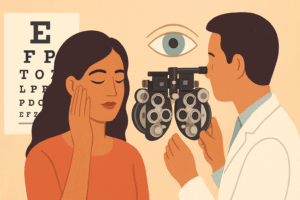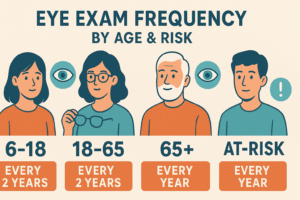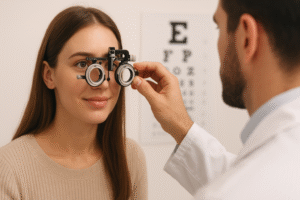When was the last time you scheduled an eye exam? For many people, the question isn’t whether they should see an eye doctor, but how often they should get an eye exam. The truth is, regular eye health screening does far more than update your glasses prescription. An eye exam can uncover early signs of vision problems, detect hidden eye diseases such as glaucoma, and even reveal systemic health conditions like diabetes or high blood pressure.
Unlike a quick vision test at school or the DMV, a professional exam performed by an optometrist or ophthalmologist is designed to evaluate the entire visual system. From checking visual acuity with a Snellen chart to assessing eye pressure, these visits give a clear picture of both your eyesight and your overall well-being.
Eye care services aren’t just for people who already struggle with blurry vision. Children, adults, and seniors all benefit from regular exams tailored to their age and risk factors. By understanding how often you should get an eye exam, you can protect your vision long before problems interfere with daily life. Think of it as preventive care — a small investment of time that safeguards one of your most important senses.
What is an Eye Exam?
An eye exam is much more than reading letters off a chart. At its core, it’s a structured evaluation of your vision and eye health, carried out by an optometrist or ophthalmologist. The type of exam you need depends on your age, risk factors, and whether you wear corrective lenses.
It goes beyond a simple vision screening to assess every part of the eye — from the cornea and lens to the retina and optic nerve. This is where tests such as refraction, slit-lamp examination, eye pressure measurement (tonometry), and retinal imaging come into play. These assessments allow your doctor to spot issues early, often before you notice symptoms.
There are also more focused evaluations. A contact lens exam ensures a proper fit for safe, comfortable wear, while a dilated eye exam gives the doctor a closer look at the back of the eye. Quick vision screenings, like those done at schools or health fairs, are helpful but not a replacement for a full exam.
How Often Should I Get an Eye Exam?
One of the most common questions patients ask is: How often should I get an eye exam? The answer depends on several factors, including your age, health history, and whether you already wear glasses or contact lenses. While guidelines may vary slightly between organizations, most experts agree on the following schedule.
Children and Teens
Children should receive their first pediatric eye exam between 6 and 12 months of age. Another check is recommended around age 3, again before starting school, and then every 1–2 years throughout childhood. These exams are critical for detecting conditions like lazy eye (amblyopia) or focusing problems that can affect learning. Even if a child passes a school vision screening, it doesn’t replace a full exam by an optometrist.
Adults 18–39
For young adults with no vision problems, every two years is usually sufficient. However, if you wear corrective lenses, have diabetes, or notice frequent headaches or blurry vision, you may need more frequent visits. Asking yourself how often you should get an eye exam is especially important if you work long hours on screens, since digital eye strain can mask other issues.
Adults 40–59
This is the age when early signs of glaucoma, macular degeneration, or cataracts may appear. At this stage, most people should have an eye exam every 2 years, but those with risk factors — such as family history of eye disease or systemic conditions like high blood pressure — should schedule annual visits. A glaucoma screening is often included during these exams.
Seniors 60+
Once you reach 60, the answer to how often you should get an eye exam becomes simple: every year. Seniors are more vulnerable to cataracts, glaucoma, and age-related macular degeneration, conditions that can progress silently without regular monitoring.
High-Risk Individuals
If you have diabetes, a family history of glaucoma, previous eye surgery, or sudden vision changes, you should not wait the standard interval. Annual or even more frequent exams may be necessary.
In summary, the frequency of eye exams changes throughout life. Whether you’re scheduling a pediatric eye exam for your child, maintaining healthy vision in adulthood, or monitoring age-related changes as a senior, the safest approach is to ask your doctor how often you should get an eye exam for your specific needs.
What Happens During a Comprehensive Eye Exam?
A comprehensive eye exam is the most thorough way to evaluate both vision and overall eye health. Unlike a quick vision screening, this process uses a series of specialized eye exam tests to assess every part of the visual system. Here’s what typically happens during an appointment:
1. Medical History and Symptoms
Your eye doctor begins by asking about your medical history, medications, and any vision changes you’ve noticed. This context helps guide the rest of the exam and ensures risk factors like diabetes or family history of glaucoma are considered.
2. Visual Acuity Test
This is the part most people recognize — reading letters from a Snellen chart. It measures how clearly you can see at different distances.
3. Refraction
If you need glasses or contact lenses, refraction determines the exact prescription. Using a phoropter, your optometrist or ophthalmologist asks which lens options look clearer to fine-tune your vision correction.
4. Slit-Lamp Examination
A slit lamp is a microscope with a bright light that allows the doctor to inspect the cornea, lens, and iris in detail. This test can detect cataracts, corneal issues, and signs of infection.
5. Eye Pressure Test (Tonometry)
Measuring intraocular pressure is key for detecting glaucoma risk. This may be done with a gentle puff of air or a small probe that briefly touches the eye’s surface.
6. Pupil and Eye Muscle Function
Your doctor may test how your pupils react to light and check how your eyes move together, which can reveal neurological or muscular issues.
7. Dilated Eye Exam
For a closer look at the back of the eye, drops are used to dilate the pupils. This allows the doctor to thoroughly examine the retina, optic nerve, and blood vessels. Although your vision will be blurry for a few hours afterward, a dilated eye exam is essential for detecting early signs of diabetic retinopathy, macular degeneration, or optic nerve damage.
8. Retinal Imaging and OCT
Some clinics use advanced tools like optical coherence tomography (OCT) to capture high-resolution images of the retina. These scans help identify subtle changes that may not be visible through standard methods.

Why Dilated Eye Exams Are Important
A dilated eye exam gives your doctor the widest possible view of the inside of your eyes. Using special drops, the pupils are temporarily enlarged, allowing a detailed look at the retina, optic nerve, and blood vessels. While your vision may be blurry and light-sensitive for a few hours afterward, the benefits far outweigh the inconvenience.
Many serious conditions, including diabetic retinopathy, macular degeneration, and glaucoma, develop silently without early symptoms. A standard vision test or quick screening cannot reveal these changes, but a retinal exam with dilation can. In fact, doctors often detect systemic health issues such as hypertension or diabetes during a dilated exam.
For high-risk groups — people with diabetes, a family history of eye disease, or anyone over 60 — dilation is essential. When combined with modern retinal imaging or glaucoma screening, it becomes one of the most effective ways to protect long-term vision.
Eye Exam Frequency by Age & Risk
Many people still wonder, How often should I get an eye exam if I feel my vision is fine. The answer depends largely on age and risk level.
Children: A pediatric eye exam should be done at 6–12 months, again before school, and every 1–2 years afterward.
Adults 18–39: A full vision check every 2 years is usually enough unless you wear corrective lenses or have health concerns.
Adults 40–59: At this stage, exams every 2 years are recommended, with annual visits if you have risk factors like diabetes or a family history of glaucoma.
Seniors 60+: An eye exam for seniors should be scheduled yearly to monitor for cataracts, macular degeneration, and glaucoma.
If you’re high-risk — diabetic, prone to hypertension, or with a family history of eye disease — your doctor may recommend more frequent glaucoma screening and dilated exams.

What Health Conditions Eye Exams Can Detect
An eye exam does much more than confirm whether you need new glasses. During a retinal exam or eye health screening, doctors can identify early signs of conditions that affect not only the eyes but the entire body.
For example, changes in the blood vessels of the retina may point to diabetes or hypertension long before other symptoms appear. Swelling of the optic nerve can signal neurological conditions, while irregularities in the retina may be linked to autoimmune or vascular diseases. A comprehensive exam also detects eye-specific problems such as glaucoma, cataracts, and macular degeneration, which can cause permanent vision loss if untreated.
Because the eyes are one of the few places where blood vessels and nerves are visible without surgery, they serve as a window into your overall health. That’s why regular exams are considered a vital form of preventive care — not just vision correction.
Preparing for Your Eye Exam
Getting ready for your eye doctor appointment is simple, but a little preparation helps you get the most out of your visit. Start by bringing your current glasses or contact lenses, along with a list of any medications you take. If you’ve noticed changes in your sight, write them down so you can share them with your doctor.
It’s also useful to know your family’s eye health and medical history, especially if there’s a record of glaucoma, macular degeneration, or diabetes. Some clinics provide an eye exam checklist in advance to help you prepare.
Finally, be ready for a vision test and possibly a dilated exam, which may make your eyes light-sensitive for a few hours afterward.

Costs, Insurance, and Accessibility
One of the most common concerns people have is the eye exam cost. Prices vary depending on whether you’re visiting an independent optometrist, a retail clinic, or an ophthalmology practice. On average, a routine eye exam may range from $50 to $150, with specialty testing costing more.
If you have vision insurance, many plans cover part or all of the cost, often including discounts on glasses or contacts. For those without coverage, many clinics and community health centers provide affordable eye care options, sometimes offering sliding-scale fees.
The key is not to delay your appointment due to cost. Clear vision and early detection of health issues often save far more in the long run.
Conclusion
Your eyes are more than windows to the world — they’re also windows to your health. Knowing how often you should get an eye exam is the first step toward protecting both your vision and overall well-being. Whether you’re a child starting school, an adult balancing screen time, or a senior monitoring age-related changes, routine exams ensure that small issues don’t become major problems.
With today’s advanced technology, an exam is quick, painless, and highly informative. It can confirm that your glasses or contact lenses are up to date, detect eye diseases early, and even reveal systemic health concerns. Don’t wait until you notice changes in your sight — schedule your next exam and keep your vision clear for years to come.
FAQs
1. How often should I get an eye exam?
Most healthy adults should schedule an exam every 1–2 years. Children and seniors usually need more frequent checkups, and people with conditions like diabetes or a family history of glaucoma may benefit from annual visits.
2. What’s the difference between a vision screening and a comprehensive eye exam?
A vision screening, like those done at schools or health fairs, only checks basic visual acuity. A comprehensive eye exam includes a retinal check, glaucoma test, and overall eye health assessment.
3. At what age should children start getting eye exams?
A pediatric eye exam should take place between 6–12 months of age, again before preschool, and then every 1–2 years unless the child has specific vision issues.
4. Does an eye exam include a glaucoma test?
Yes. Most exams include a glaucoma test, often by measuring eye pressure or checking the optic nerve for damage. This is especially important after age 40.
5. How much does an eye exam cost without insurance?
The eye exam cost typically ranges from $50 to $150, depending on the clinic and whether additional tests are required.

